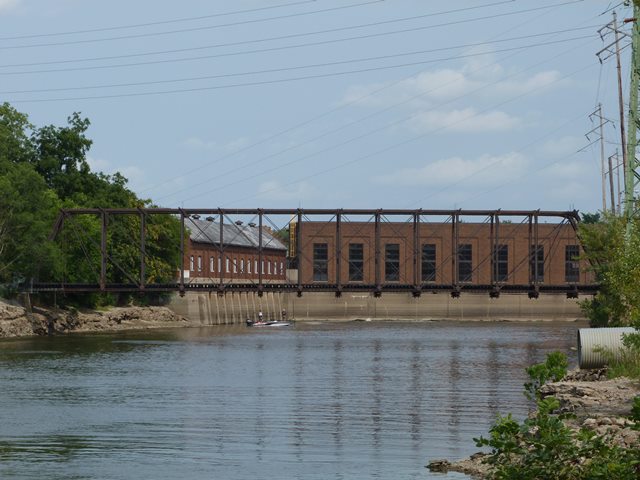We Recommend:
Bach Steel - Experts at historic truss bridge restoration.
Sylvan Island Railroad Bridge

Primary Photographer(s): Nathan Holth
Bridge Documented: August 11, 2013
Moline: Rock Island County, Illinois: United States
Metal (Cast Iron) 15 Panel Multiple-Type-Connected Whipple (Double-Intersection Pratt) Through Truss, Fixed
1868 By Builder/Contractor: Detroit Bridge and Iron Works of Detroit, Michigan and Engineer/Design: Thomas Curtis Clarke
Not Available or Not Applicable
195.0 Feet (59.4 Meters)
202.0 Feet (61.6 Meters)
Not Available
1 Main Span(s)
Not Applicable

View Information About HSR Ratings
Bridge Documentation
View A Historical Report Discussing A Bridge At Quincy, Illinois With Similar Details As This Bridge
View A Biography of Thomas Curtis Clarke
This bridge was one span of a Mississippi River railroad bridge in Burlington, Iowa that was built in 1868. In 1891, that bridge was replaced and one of the spans was moved here to Sylvan Island. Some sources say it was shortened by 45 feet at this time. Closer inspection of this bridge was not possible to confirm this visually and determine the method by which this was done. Here on Sylvan island, the bridge served as a railroad bridge for an unknown number of years until it was abandoned in place.
This may be one of the best kept secrets in the historic bridge world. Few bridges with such great historic significance have ever received so little attention. This is a nationally significant bridge, with overlaying areas of significance. Each individual area of significance would make this a bridge with high historic significance, but to find all these areas of significance on a single bridge is quite amazing. The bridge was originally built in 1868. Metal truss bridges from the 1870s are considered extremely old. Bridges built in the 1860s or earlier are among the oldest surviving metal bridges in the country. Moreover, the bridge is a rare example of a bridge that represents the materials and designs of an early Mississippi River bridge is from the first generation of metal railroad bridges, nearly all of which were lost a few decades after they were built due to a need for stronger railroad bridges which occurred around the turn of the 20th Century. The bridge has cast iron compression members, specifically the top chord (and only the top chord) of the bridge. Any bridge with cast iron members automatically join one of the rarest groups of historic bridges in the country. Most cast iron truss bridges are in the eastern United States, so surviving cast iron bridges in other regions of the United States are regionally even more rare. The end posts and all but the hip verticals of the bridge are another rare type of truss beam, the patented wrought iron Phoenix Column as manufactured by the Phoenix Iron Company. Any bridge with Phoenix Columns is a rare example of its kind and significant for displaying the patented design of column. Phoenix Column bridges are also mostly found in the eastern United States and are less common in this region. The bridge has a Whipple truss configuration. Whipple truss bridges of any kind are uncommon, but are particularly uncommon among surviving railroad bridges. exceedingly rare surviving example of an early generation metal railroad bridge. Take all of these aspects of significance and combine them into a single bridge and it is clear why this bridge has the highest possible Historic Significance Rating awarded by HistoricBridges.org.
This bridge is abandoned. The north end connects to Sylvan Island, a public park. The south end leads to some sort of electrical substation. This bridge should receive the absolute highest preservation priority. It deserves to have people falling over each other trying to save it (much like one would find with any covered bridge). This bridge is far more rare than any covered bridge due to its combination of cast iron, Phoenix Columns, and Whipple truss design. It is a remnant of a generation of railroad bridges of which nearly nothing remains in the entire country. At the very least, one preservation solution would be to re-deck the bridge for pedestrians and just use it as an outlook, and keep it fenced off at the south end. This would be quite similar to the Bergfeld Pond Bridge.
Unfortunately because the Sylvan Island Park was closed when HistoricBridges.org visited this bridge, only a few overview photos are available, far less than what this bridge deserves. A return visit is needed!
![]()
Photo Galleries and Videos: Sylvan Island Railroad Bridge
Bridge Photo-Documentation
Original / Full Size PhotosA collection of overview and detail photos. This gallery offers photos in the highest available resolution and file size in a touch-friendly popup viewer.
Alternatively, Browse Without Using Viewer
![]()
Bridge Photo-Documentation
Mobile Optimized PhotosA collection of overview and detail photos. This gallery features data-friendly, fast-loading photos in a touch-friendly popup viewer.
Alternatively, Browse Without Using Viewer
![]()
Maps and Links: Sylvan Island Railroad Bridge
Coordinates (Latitude, Longitude):
Search For Additional Bridge Listings:
Bridgehunter.com: View listed bridges within 0.5 miles (0.8 kilometers) of this bridge.
Bridgehunter.com: View listed bridges within 10 miles (16 kilometers) of this bridge.
Additional Maps:
Google Streetview (If Available)
GeoHack (Additional Links and Coordinates)
Apple Maps (Via DuckDuckGo Search)
Apple Maps (Apple devices only)
Android: Open Location In Your Map or GPS App
Flickr Gallery (Find Nearby Photos)
Wikimedia Commons (Find Nearby Photos)
Directions Via Sygic For Android
Directions Via Sygic For iOS and Android Dolphin Browser
USGS National Map (United States Only)
Historical USGS Topo Maps (United States Only)
Historic Aerials (United States Only)
CalTopo Maps (United States Only)


